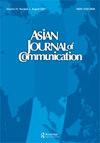“我不是病毒”:唐纳德·特朗普言论中的亚裔仇恨
IF 1.5
2区 文学
Q2 COMMUNICATION
引用次数: 0
摘要
摘要自新冠肺炎爆发以来,反亚裔情绪高涨。从2020年3月到2021年6月,美国共有9081起自我报告的仇恨事件(停止AAPI仇恨。(2021)。https://stopaapihate.org/stop-aapi-hate-national-report-2/)。随着新冠肺炎在美国传播,特朗普总统立即指责中国,称该病毒为“中国病毒”,并在推特上使用了#ChineseVirus标签(Weise,E.2021)。唐纳德·特朗普首次在推特上将新冠肺炎与中国联系起来后,反阿标签飙升。(《今日美国》。https://www.usatoday.com)。在特朗普发布关于“中国病毒”的推文后,推特上表达的反亚裔言论愈演愈烈,中国和其他亚裔仇恨犯罪的数量呈指数级增长。这项研究探讨了特朗普用来制造对危险的“他者”的恐惧感的修辞策略我们使用修辞主题分析来分析特朗普的推文中包含“中国病毒”或“功夫流感”等语言替罪羊、对他人的恐惧、抨击中国和民粹主义诉求等主题普遍存在。将中国人和其他亚洲人描述为疾病的“传播者”,强化了黄祸和永久的外国人刻板印象。该研究表明,在新冠肺炎和亚洲仇恨的背景下,总统言论在影响公众舆论方面的重要性。本文章由计算机程序翻译,如有差异,请以英文原文为准。
‘I’m not a virus’: Asian hate in Donald Trump’s rhetoric
ABSTRACT Since the start of Covid-19, anti-Asian sentiment spiked. From March 2020 to June 2021, there were a total of 9,081 self-reported incidents of hate across the United States (Stop AAPI Hate. (2021). https://stopaapihate.org/stop-aapi-hate-national-report-2/). As Covid-19 spread into the U.S., President Trump immediately blamed China by referring to the virus as the ‘Chinese Virus’ and used the hashtag #ChineseVirus on Twitter (Weise, E. 2021). Anti-Asian hashtags soared after Donald Trump first tied COVID-19 to China on Twitter. (USA Today. https://www.usatoday.com). Anti-Asian rhetoric expressed on Twitter grew after Trump’s tweet about the ‘Chinese virus,’ and the number of Chinese and other Asian hate crimes grew exponentially. This study explores the rhetorical strategies that Trump utilized to create a sense of fear against the dangerous ‘Other.’ We use a rhetorical thematic analysis to analyze Trump’s tweets that contain language such as ‘Chinese virus’ or ‘Kung Flu.’ Themes such as scapegoating, fear of the other, China bashing, and populist appeals were prevalent. Describing Chinese and other Asian bodies as ‘spreaders’ of diseases, reinforces the Yellow Peril and perpetual foreigner stereotypes. The study shows the importance of presidential rhetoric in influencing public opinion in the context of COVID-19 and Asian hate.
求助全文
通过发布文献求助,成功后即可免费获取论文全文。
去求助
来源期刊

Asian Journal of Communication
COMMUNICATION-
CiteScore
3.70
自引率
0.00%
发文量
38
期刊介绍:
Launched in 1990, Asian Journal of Communication (AJC) is a refereed international publication that provides a venue for high-quality communication scholarship with an Asian focus and perspectives from the region. We aim to highlight research on the systems and processes of communication in the Asia-Pacific region and among Asian communities around the world to a wide international audience. It publishes articles that report empirical studies, develop communication theory, and enhance research methodology. AJC is accepted by and listed in the Social Science Citation Index (SSCI) published by Clarivate Analytics. The journal is housed editorially at the Wee Kim Wee School of Communication and Information at Nanyang Technological University in Singapore, jointly with the Asian Media Information and Communication Centre (AMIC).
 求助内容:
求助内容: 应助结果提醒方式:
应助结果提醒方式:


